Late blight was confirmed in an organic tomato field late last week south of Bridgeton, New Jersey. As a note, growers who are still picking tomatoes should continue to scout up until the final pick and destroy field as soon as possible once harvesting is finished either by applying gramoxone or discing under plant material. Growers with late blight issues this growing season should be especially diligent. The threat of late blight in our area will remain up until the first frost. Late blight has the potential to overwinter in our area on infested potatoes left in cull piles or unharvested tubers left in the field.
Angular Leaf Spot in Fall Transplanted-Strawberries
There have been a few reports of angular leaf spot (ALS) caused by the bacterium, Xanthomonas fragariae, in strawberry in the northern part of New Jersey. Often considered a minor pathogen, ALS can cause serious leaf and calyx infections ruining the marketability of fruit if left uncontrolled. Like all bacterium, the pathogen will infect leaves and the calyx through natural openings or wounds.
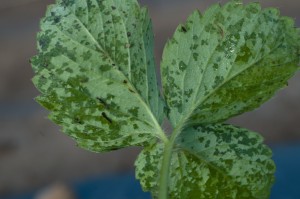
Fig. 1. Water-soaked lesions caused by angular leaf spot on infect strawberry leaf. Photo by P. Nitzsche
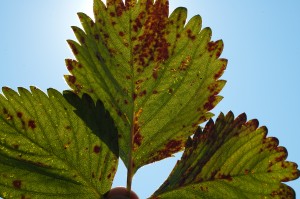
Fig. 2. Reddish-brown lesions on infected strawberry leaf caused by angular leaf spot. Note the translucent spots when held up to light. Photo by P. Nitzsche
Importantly, in severe outbreaks in the spring, the bacterium can spread to fruit causing the calyx to turn brown and dry out ruining the marketability of infected fruit (Figs. 3 & 4).

Fig. 3. Angular leaf spot infections on calyx of infected strawberry fruit. Photo by P. Nitzsche
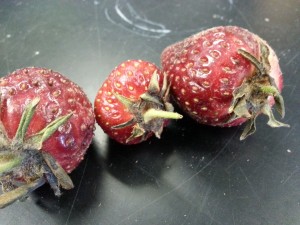
Fig 4. Strawberry fruit infected with Angular leaf spot. Note the brown, dried up calyx.
The pathogen is easily spread via overhead irrigation and during rain and can be moved around the field during harvest. The bacterium may overwinter on infected plant debris buried in the soil for up to one year. The best method for controlling angular leaf spot is to buy clean transplant material. Conventional or organic copper-based products can help suppress the development of ALS, and should be applied at a low rate to avoid phytotoxicity in leaves. Weekly, preventative applications of 0.3 lb fixed copper have been shown to be effective in reducing ALS if applied early enough when disease pressure was still low.
Vegetable Disease Briefs – 9/28/13
Basil downy mildew remains active. The weather this time of year is ideal for downy mildew development across many crops. Growers should remain diligent going into the fall with regular scouting and preventative fungicide applications. [Read more…]
Late Blight Reported: S.NJ Greenhouse Tomato – 9/21/13
An isolated case of Late blight has been confirmed in Southern New Jersey on a farm that was growing both field-grown and greenhouse-grown tomatoes. The pathogen originated in an old tomato planting that had been unsprayed since the last pick over 6 weeks ago. Left unscouted, the field developed Late blight and the pathogen moved into the greenhouse operation within days of an otherwise healthy-looking greenhouse tomato crop.
As a reminder any crop, conventional or organic, left standing in a field after last harvest will only act to serve as a source of potential incoculum for many diseases. As with tomatoes and other crops, all should be disced down, tilled, and/or mowed down as soon as possible after harvest. Conventionally, applying the herbicide, gramoxone, is also an easy way to achieve this. Organic growers need to be just as diligent and disc down, till, or pull old plantings soon after use.
For more on the control of Late blight in tomato please see the 2013 Commercial Vegetable Production Recommendations Guide.
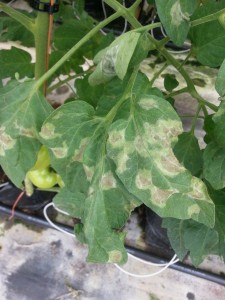 Late blight in Greenhouse Tomato |
Late blight lesions developing on a greenhouse grown tomato plant. Under dryer, less humid conditions the lesions may not have the characterstic dark, greasy appearance. |
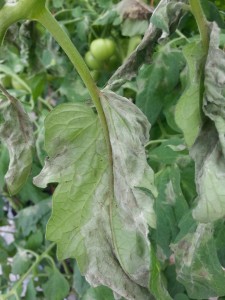 Late blight in GH Tomato |
Late blight sporulating on the underside of an infected tomato leaf. Note the pure white sporangia (spores) on the underside of the leaf. |
Vegetable Disease Briefs – 9/20/13
Late blight has been reported in tomato on an organic farm near Long Valley in Morris County, New Jersey. The cooler weather along with longer periods of leaf wetness lasting into the morning hours this time of year makes conditions ideal for potential Late blight development. As a reminder, once fields or blocks of tomatoes are finished, care should be taken to burn down, remove, or disc down the foliage. Fields left un kept can act as a source of inoculum. Tomato fields should be scouted on a regular basis. Regular protectant fungicide programs should continue as long as fields or blocks are in production. Organic tomato growers can apply an OMRI-approved copper fungicides to help suppress late blight development.
Vegetable Disease Update – 9/20/13
Carrots – Leaf blights – Powdery mildew, Alternaria and Cercospora. Alternaria and Cercospora are two soil-borne fungal pathogens that may cause early defoliation in carrots reducing yields and making harvest difficult. Both pathogens produce distinct symptoms on carrots. [Read more…]
